What is Skin Cancer?
Skin Cancer
Skin cancer is the uncontrollable growth of abnormal cells in a layer of the skin. It attacks one out of every seven Americans each year, making it the most prevalent form of cancer. However, ninety percent of all skin cancers can be cured if detected and treated in time.
There are several different kinds of skin cancers, distinguished by the types of cells affected. The three most common forms of skin cancer are:
Basal cell carcinoma – usually appears as raised, translucent lumps. This cancer develops in 300,000 to 400,000 persons each year. Although the disease does not usually spread to other parts of the body through the blood stream, it may cause considerable damage by direct growth and invasion.
Squamous cell carcinoma – usually distinguished by raised repish lumps or growths. This form of cancer develops in 80,000 to 100,000 persons per year. The disease can spread to other parts of the body. Approximately 2,000 deaths occur each year from this form of cancer
How to Treat Skin Cancer
From a publication of the American Society For Dermatologic Surgery (ASDS) 1-800-441-2737
A dermatologic surgeon selects the most appropriate treatment for a particular skin cancer or precancerous condition from among the following procedures and techniques:
Curettage, in which malignant tissue is scraped away with a sharp instrument. This method is most effective for small, superficial cancers that have not been treated previously. It is often followed by destruction of the cancerous tissue with an electric neepe.
Surgical excision, or cutting into the skin and removing the growth. The skin is then closed with stitches.
Cryosurgery, in which liquid nitrogen is applied directly to the skin to freeze cancerous tissue.
Topical chemotherapy, or the application to the skin surface of chemicals capable of destroying precancerous growths.
MOHS micrographic surgery, or excision of a tumor and its surrounding skin with the aid of a microscope. This method allows the dermatologic surgeon to trace the outline of a cancerous growth, layer by layer, with exceptional accuracy.
Laser surgery, in which intense waves of light are beamed at cancerous skin to cut away or vaporize the tissue.





















